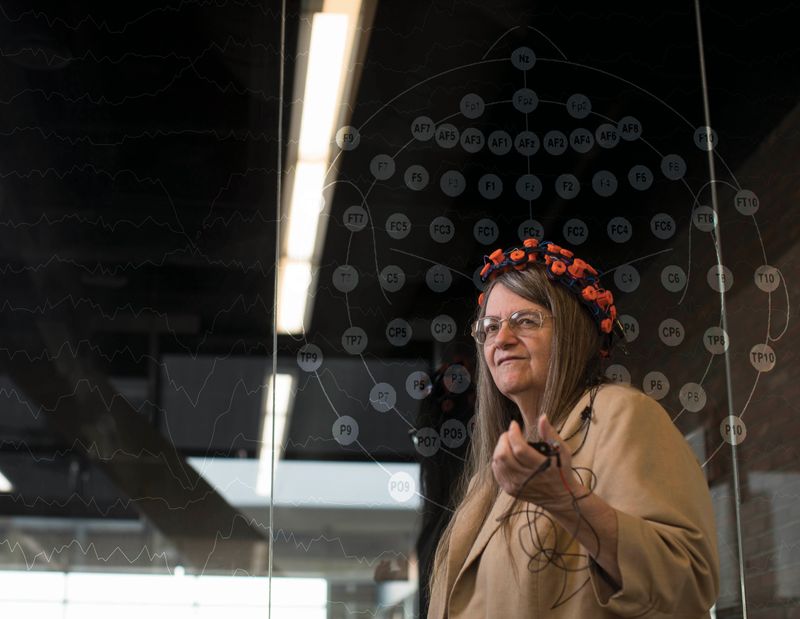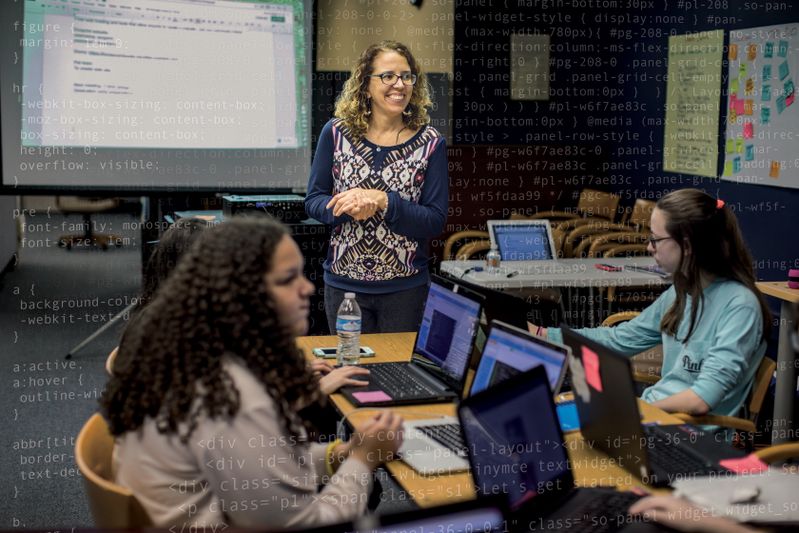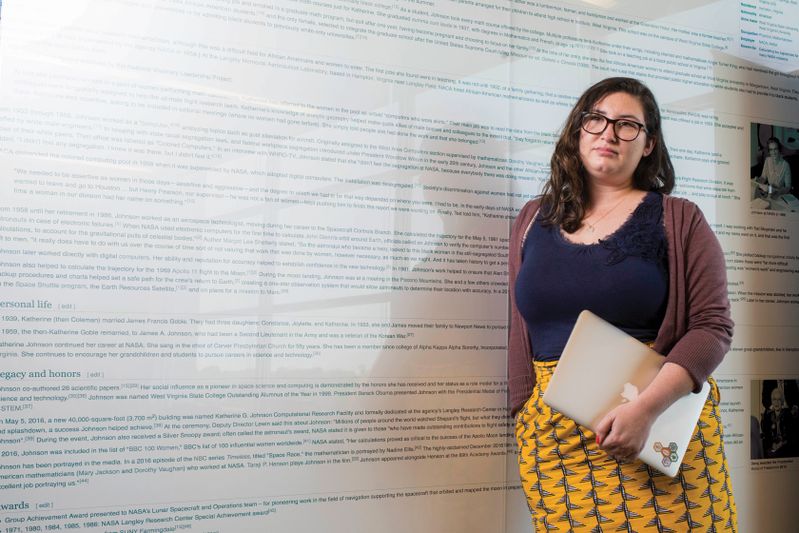“I was devastated; I am smart and capable — just as much as the men who were being hired,” said Frances Van Scoy, associate professor in the Benjamin M. Statler College of Engineering and Mineral Resources.
“My professors were appalled. They would say, ‘You’re bright enough to do a PhD in mathematics, why would you lower yourself to computer science? You’ll never find a job with a computer science degree,’” she said. “But I saw computer science at the time as being a new field, wide open for new people, lots of things that hadn’t been thought of yet — and more room to be creative.”
She hasn’t stopped creating since becoming the first woman to receive a PhD in computer science from the University of Virginia. In 1979, she received an invitation from WVU to help launch a computer science PhD program. Among her many achievements, she laid the foundation for the University’s software engineering master’s program, developed narrative-based computer games and created technology to assist students with visual impairments to learn math.
She became adviser for the Game Developers Club and, along with other computer science professors at the University, she created game development courses that have helped several students become game developers.
And then there’s her latest project. Van Scoy — who is also a writer — thought while at a conference in 2008: What if she could transmit what she saw and heard in her imagination directly to text and video files?

The results? The software correctly understood anchovies and mushrooms every time, but ground beef and Italian sausage were matched incorrectly more than 50 percent of the time. But Van Scoy saw the identification failure as an indicator that the program was recognizing meaningful brain signals because ground beef and Italian sausage are similar.
In a speech she gave in 2013 on her acceptance into the Lane Department of Computer Science and Electrical Engineering Academy of Distinguished Alumni, she talked about one day being able to make a stronger link between thoughts and computers.
“The problem? I’m estimating it’ll take 20 more years for the technology to get to that point,” she told the audience. “And that means I get to push my anticipated retirement date back a few years.”
Alumna Ysabel Bombardiere sees it in the girls’ eyes: They are comfortable asking questions, they feel encouraged and there’s a sense of sisterhood.
“My daughter is a middle school girl … and there’s a huge need for those educated in computer science,” said Bombardiere, BS ’00, Industrial Engineering. “Girls my daughter’s age begin to lose interest in engineering and math, and I wanted to help do something.”

“They’re tech savvy and very ambitious. They want to do amazing things, so we let them decide what project they want to pursue and we give them the tools to get there,” she said.
Bombardiere has helped to create other chapters in the Charleston area, and plans for more are in the works. If you’d like to open a chapter in your area, visit girlswhocode.com.
“Being in this club is like a secret super power,” Bombardiere said. “They might not talk about it, but it gives them a lot of confidence and lets them know they can do whatever they want.”
Kelly Doyle is that Wikipedian. Her job is to show how women have fit into our history and encourage women to have an equal representation on Wikipedia. In other words, women have been doing incredible things since the beginning of time — but if no one documents it, how do we know that it happened?

“Less than 10 percent of people who edit Wikipedia are women, and only 16 percent of biographies are about women. So, if it’s only men who are writing about other men, we’re missing half our history — and if it doesn’t exist on Wikipedia, it might not exist anywhere.”
To help change that, Doyle has hosted edit-a-thons where students learn to edit Wikipedia and offered service credit for those who can help fill those gaps in every industry and every field.
On her watch, students have created more than 50 articles on Wikipedia related to women from West Virginia. And another 100 existing articles on women from the state have been edited and improved.
“My knowledge is that the gaps are comprehensive and across every industry,” Doyle said. “There are notable women missing, and if we can help fill in a piece of that story, we’re helping to more accurately portray information and sending a clear message that women contribute significantly — even if they haven’t been credited.
“And, that sends a clear message — that women have been a huge part of history, and they will continue to be.”
It was commonplace, then — and sometimes now — for women in technology fields to face discrimination based on what was expected of them because of their gender.
But, as we know now, women have had a role in developing important technology. And the women who work at or who have attended the University are notable examples.
They have blazed trails in computer science, created coding clubs for girls and made a place for women on Wikipedia.
Note to Self
Van Scoy’s undergraduate professors didn’t agree with her pursuit of computer science, which wasn’t considered prestigious compared to math.
“My professors were appalled. They would say, ‘You’re bright enough to do a PhD in mathematics, why would you lower yourself to computer science? You’ll never find a job with a computer science degree,’” she said. “But I saw computer science at the time as being a new field, wide open for new people, lots of things that hadn’t been thought of yet — and more room to be creative.”
She hasn’t stopped creating since becoming the first woman to receive a PhD in computer science from the University of Virginia. In 1979, she received an invitation from WVU to help launch a computer science PhD program. Among her many achievements, she laid the foundation for the University’s software engineering master’s program, developed narrative-based computer games and created technology to assist students with visual impairments to learn math.
She became adviser for the Game Developers Club and, along with other computer science professors at the University, she created game development courses that have helped several students become game developers.
And then there’s her latest project. Van Scoy — who is also a writer — thought while at a conference in 2008: What if she could transmit what she saw and heard in her imagination directly to text and video files?
COMPUTER SCIENCE ASSOCIATE PROFESSOR FRANCES VAN SCOY IS WEARING AN EMOTIV EEG HEADSET THAT SHE AND HER STUDENTS HAVE USED TO DEVELOP PROTOTYPE PIZZA-ORDERING SOFTWARE.
In 2014, Van Scoy and her students used the commercial Emotiv EEG headset to develop prototype software for a thought-controlled pizza ordering system. They trained software to identify thoughts about pizza toppings. And then had subjects think about one of 40 toppings.
The results? The software correctly understood anchovies and mushrooms every time, but ground beef and Italian sausage were matched incorrectly more than 50 percent of the time. But Van Scoy saw the identification failure as an indicator that the program was recognizing meaningful brain signals because ground beef and Italian sausage are similar.
In a later project, she and her students created a pilot program using neuroheadsets that would allow people with aphasia — an inability to speak or understand speech — to indicate that they are thirsty or need to use the bathroom. She’s continuing to build on these projects in collaboration with neurologist Vijayalakshmi Rajasekaran and associate professor Dana Coester in the Reed College of Media.
In a speech she gave in 2013 on her acceptance into the Lane Department of Computer Science and Electrical Engineering Academy of Distinguished Alumni, she talked about one day being able to make a stronger link between thoughts and computers.
“The problem? I’m estimating it’ll take 20 more years for the technology to get to that point,” she told the audience. “And that means I get to push my anticipated retirement date back a few years.”
Code On, Girls
There’s something special that happens when girls support other girls.
Alumna Ysabel Bombardiere sees it in the girls’ eyes: They are comfortable asking questions, they feel encouraged and there’s a sense of sisterhood.
The Girls Who Code Club, a WVU Extension Service 4-H program created in part by Bombardiere, helps spark young girls’ interest in computer science. The program ultimately seeks to encourage more girls to enter STEM fields and explore more career options.
“My daughter is a middle school girl … and there’s a huge need for those educated in computer science,” said Bombardiere, BS ’00, Industrial Engineering. “Girls my daughter’s age begin to lose interest in engineering and math, and I wanted to help do something.”
ALUMNA YSABEL BOMBARDIERE, AN ENIGNEER, LEADS THE GIRLS WHO CODE CLUB AT THE KANAWHA COUNTY WVU EXTENSION OFFICE BECAUSE SHE WANTS GIRLS TO BE A BLE TO CONSIDER CAREERS IN TECHNOLOGY.
With the help of the Kanawha County Extension Service, the coding club became a reality where girls gather to learn about coding programs like Python, Javascript, HTML and CSS through making webpages, mock apps and games.
“They’re tech savvy and very ambitious. They want to do amazing things, so we let them decide what project they want to pursue and we give them the tools to get there,” she said.
Bombardiere has helped to create other chapters in the Charleston area, and plans for more are in the works. If you’d like to open a chapter in your area, visit girlswhocode.com.
“Being in this club is like a secret super power,” Bombardiere said. “They might not talk about it, but it gives them a lot of confidence and lets them know they can do whatever they want.”
Fixing the Past for the Future
WVU has the first ever Wikipedian-in- Residence for Gender Equity.
Kelly Doyle is that Wikipedian. Her job is to show how women have fit into our history and encourage women to have an equal representation on Wikipedia. In other words, women have been doing incredible things since the beginning of time — but if no one documents it, how do we know that it happened?
KELLY DOYLE IS THE FIRST WIKIPEDIAN-IN-RESIDENCE FOR GENDER EQUITY, A ROLE WHERE SHE INCREASES THE NUMBER OF WIKIPEDIA ARTICLES RELATED TO WOMEN FROM WEST VIRGINIA. BEHIND HER IS THE WIKIPEDIA ENTRY FOR KATHERINE JOHNSON OF THE MOVIE “HIDDEN FIGURES.”
“Wikipedia is the seventh-mostvisited website globally,” Doyle said. “If you Google anything, Wikipedia comes up first. If you can’t find information about a person — like Katherine Johnson [of the movie “Hidden Figures” fame] — or that information is behind a paywall, how does that person fit into history? Is that person notable?
“Less than 10 percent of people who edit Wikipedia are women, and only 16 percent of biographies are about women. So, if it’s only men who are writing about other men, we’re missing half our history — and if it doesn’t exist on Wikipedia, it might not exist anywhere.”
To help change that, Doyle has hosted edit-a-thons where students learn to edit Wikipedia and offered service credit for those who can help fill those gaps in every industry and every field.
On her watch, students have created more than 50 articles on Wikipedia related to women from West Virginia. And another 100 existing articles on women from the state have been edited and improved.
“My knowledge is that the gaps are comprehensive and across every industry,” Doyle said. “There are notable women missing, and if we can help fill in a piece of that story, we’re helping to more accurately portray information and sending a clear message that women contribute significantly — even if they haven’t been credited.
“And, that sends a clear message — that women have been a huge part of history, and they will continue to be.”
